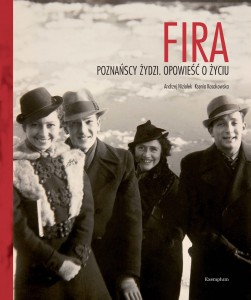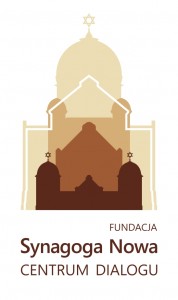Project Fira
Fira, photographs of Poznan Jews
 One story and over seven hundred photographs. They are like tangible evidence that those people got in love, had fun, experienced failures or fear, dreamed and planned their future. They were young with their whole lives ahead of them. And then, they got killed. Poznan Jews of the interwar period. We don’t know much about them. They are like Atlantis, anonymous and lost. There are no photographs, no faces, no memories of them. There are no names, no stories. There are only dumb places.
One story and over seven hundred photographs. They are like tangible evidence that those people got in love, had fun, experienced failures or fear, dreamed and planned their future. They were young with their whole lives ahead of them. And then, they got killed. Poznan Jews of the interwar period. We don’t know much about them. They are like Atlantis, anonymous and lost. There are no photographs, no faces, no memories of them. There are no names, no stories. There are only dumb places.
There were only 2500-3000 Jews in Poznan before 1939. They constituted a little over 1% of the Poznan population, which was 250 thousand people at that time. They were different from the Jews living in other regions of Poland and more similar to those of Western Europe. There were no Hasidic or Orthodox Jews among them. There was no Yiddish heard in the streets. All Poznan Jews lived like the people around them. They spoke Polish, got dressed like the others and weren’t religious. So, from a Poznan perspective, Jewish Poland is far from the stereotypical image.
The project Fira, the Jews of Poznan. A Story about Life is like a time machine or a peephole that let us look into the past. Our book-album and the website publicize a set of over one thousand photographs collected in six albums by Fira Melamedzon from Poznan. On May 31, 1939, 24-year -old Fira left for Palestine to join her father, who had been stayed there for over a year. In September, Fira’s mother closed their men’s garment shop at the Old Square Market 64, settled all emigration formalities, and eleven days before the outbreak of World War II, she disembarked at the Tel Aviv Port. This saved not only those three people but also Fira’s memories that had not been changed by the war experience.
The photographs in Fira’s albums are the unique material forming the unusual publication. Their number, which is around 1300, is unique too, especially that there have been preserved few photographs of Poznan Jews ( there are also photos presenting the Jews from Brzeziny near Lodz and other towns in the albums). It is also unique that all the photos belong to one story, which was told in 2012 by 97-year-old Fira Melamedzon-Salanska. The fact of remembering and being able to tell the details of the events that happened seventy or eighty years ago is very impressive. What makes the story even more impressive is that it had been photographed. You can hear, read and see it. The text and the pictures combine into one recollective and photographic narrative.
Fira Melamedzon-Salanska kept saying for years, „As long as I live, they live in me” and she kept telling her stories, as the people she loved could have lived only in them. She died in May 7, 2014, at the age of 99. She didn’t live to see the book, but she knew it would be published soon. We want to continue and save her account by this project. Also, we want to return to Poznan its Jewish society from before the war. We would like it to be a memory of the city and the region, and a fragment of a history of Polish Jews. We hope to bring the Wielkpolska Jews out of the non-existence, where the war pushed them. Our book and website may not save everyone, but this is probably the last direct account.
The main characters of our project are the Poznan Jews, their feelings and everyday lives. However, the collective character of the book and website is also the interwar Poznan, which is seen as the background of the photographed people. That city no longer exists today. Fira’s account of that world, even when slightly embellished, is equally exceptional as her photographs, as it tells about carefree youth and fulfilled or unfulfilled loves. This is a story about happy life, which doesn’t line up with our image of the Jews. The Anti-Semitism in Fira’s account is like snowing. It is there, but it’s not the most important element. Also, unlike her peers from other parts of Poland, Fira doesn’t wish to get out of constricting spirituality and the shtetls’ poverty, as there were no shtetls in Poznan. There is no revolt resulting from a lack of chances, or placing hopes in the left wing. Her story is different. One can say it is just a middle-class one. Certainly, it is, but what makes it so exceptional is that it is written by a person enjoying life. Fira loves, flirts, dances, laughs and lives life to the fullest. She tells about youth, falling in love, seeking happiness and shaping her life. And this developing, pulsing life crashed with our knowledge of the Holocaust, which they didn’t have, creates drama and reveals the scale of the murder.
If you are interested in this story, we encourage you to find more details in the specific elements of our project. One of them is the book-album Fira, The Jews of Poznan. A Story about Life containing almost 300 pre-war photographs from Fira’s albums and her account since 1924, when her father came to Poznan, till her leaving for Palestine in 1939. The second element is the exhibition of photographs of Poznan Jews from the albums of Fira Melamedzon-Salanska, which can be seen in the Raczynskich Library in Poznan till September 2014. The third one is our website with pages like FIRA1915.PL containing 400 photographs, FILMS with recorded Fira’s memories, and finally RECOGNIZE THEM, when you can bring us some new information completing the story.
The first presentation of our project took place in May 31, 2014. This date was settled unintentionally. Only after Fira’s death did we realize that this day was the 75th anniversary of her leaving Poland. After three-quarters of the century her photographs and stories came back to the city where they arose. It is an unbelievable coincidence of dates. Also her albums came back to Poznan. Fira Melamedzon-Salanska decided to give them to the Raczynskich Library after her death.
Fira Melamedzon-Salanska was born in April 19, 1915 in Kharkiv. Her father, Abram Melamedzon, was a Russian Jew. Her mother, Rachela nee Dymant, was a Polish Jew from Brzeziny near Lodz. Fira’s first language was Russian. Only after her family had fled Soviet Russia in 1920 and lived in Brzeziny, did she learn Polish. Fira’s father was a merchant. He run a men’s garment shop in Kharkiv, and then in Poznan. The Melamedzons moved to Palestine just before the war, avoiding death. Fira spent 75 years in Palestine, then in Israel and never came back to Poland. Nevertheless, she had felt a Polish Jew for her whole life. She got married, had two children and numerous family then. She was kind, friendly and always optimistic. Her six albums, full of photographs of the people, who were killed made her feel responsible for telling their stories. So, she kept doing it whenever someone visited her.
The authors and producers of the project:
Andrzej Niziolek, Ksenia Kosakowska, Tomasz Adamski, Tomasz Niziolek
Project contributors:

Project co-financed by:

The book-album and the website were created thanks to Samorzad Wojewodztwa Wielkopolskiego’s and Poznan City’s funding and cooperation with the Barak Kultury Foundation and the Synagoga Nova Centrum Dialogu Foundation. Using the funds of SWW the Ba-Q Theatre produced a performance „The Toast”, based on memories of Fira Melamedzon-Salanska (more: http://barakkultury.pl/pl/wydarzenie/96)

